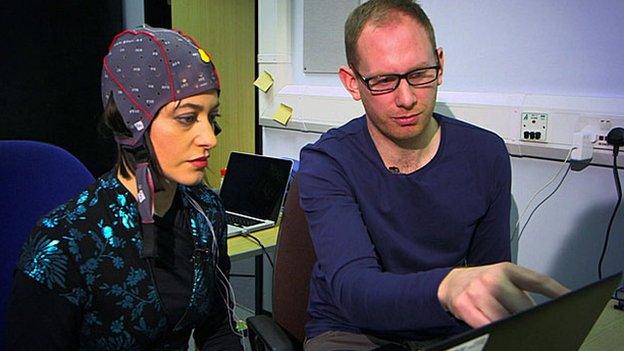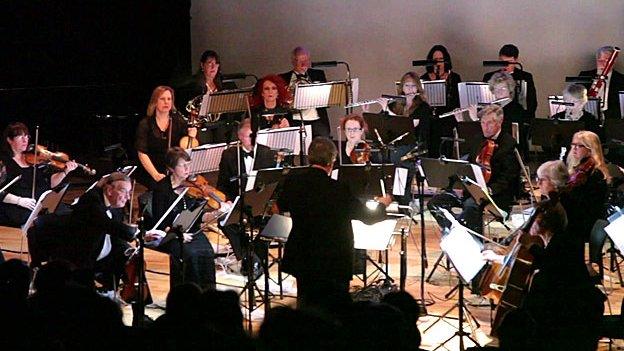How to compose classical music with your brainwaves
- Published
LJ Rich concentrates as her brainwaves are converted to cello music.
Most weeks during my classical music degree I would stare at an empty sheet of manuscript paper and wish for some kind of shortcut that would allow me to "think" the music onto the page.
Nowadays I compose on a computer, swapping pencils for pixels.
But I've always hoped that one day I could record my musical thoughts directly from my brain.
So, while staring at a laptop at Plymouth University, I'm about to try a system that promises to make my musical dream a reality.
The project is the brainchild of Professor Eduardo Miranda, a composer who has made a living out of his fascination with what he calls music neurotechnology.
His device reads thoughts, with the aid of a brain cap, and promises to translate those thoughts into music - a world away from the traditional composition process.
The professor plans to use this system to take readings from four people and then control a string quartet with the results.
This is the basis for his latest composition, entitled Activating Memory.
The piece will be performed at the 2014 Peninsula Arts Contemporary Music Festival, external in Plymouth this weekend.
He agreed to let me try the machine ahead of the performance.
Unsurprisingly I was eager to get wired up.
Clearing your mind
Researcher and engineer Joel Eaton helped me don the brain cap, complete with protruding metal electrodes and wires.

LJ Rich is wired up with the brain cap as Joel Eaton explains how music neurotechnology works.
Joel told me the main electrode at the back of my head would pick out brainwaves from my visual cortex while the other electrodes would essentially help to cancel out any background noise.
Operating the device requires the user to concentrate on one of four chequered patterns. These all flicker at different rates and each pattern makes the visual part of the brain create a sympathetic electrical signal.
The signal gets picked up by the brain cap and sent to the computer. The device works best when the rest of the brain is relaxed, so "clearing your mind" is encouraged.
The brain's electrical signals are amplified then sent to a laptop.
Joel encouraged me to stare at the pattern in a very particular way, a bit like focusing and defocusing. Sometimes I'd have to look away from the screen and look back to refresh my brain.
Get it right and the chosen pattern sends a musical phrase to a screen in front of Jane, a professional cellist. She would then play the music I generated.
It was very difficult at first. As well as focusing, defocusing and relaxing, I could not get too excited when it worked because it would knock me out of the required state to generate the signal.
That was a crucial challenge because I found the whole concept so exciting.
Strangely addictive
Of course I wished this system created musical phrases directly from my brain, but this was not the case.
Instead of composing directly, my thoughts chose from pre-prepared musical phrases. You could say I was an operator rather than a composer, where my brain became an instrument like Jane's cello. But the device was designed this way.
When we talked about my desire for a more efficient direct brain music composition interface, Prof Miranda said it might be fascinating at first but he thought it would get boring after a while.

Professor Eduardo Miranda will take readings from four people and then control a string quartet with the results.
He enjoys the challenge of an imperfect solution.
"Humans like to manipulate things - I do not wish to eliminate that [process], I want to enhance great tools to help composers to achieve that perhaps in different way," he said.
For people who have impaired mobility, there are some obvious benefits from this interface, even at this elementary stage.
The Interdisciplinary Centre for Computer Music Research (ICCMR) lab has already done some research with a sufferer of locked-in syndrome with encouraging results.
Even so, the system is nowhere near as user-friendly as I'd hoped.
Back in the lab it was surprisingly hard to master the technique. During the process my brain readings dropped so noticeably when the cello was playing, we had to recalibrate the system while I was listening to Jane playing.
I was glad to generate the signal reliably after two solid hours. Joel and Eduardo both told me that two hours was quick - it normally takes a few days to get the hang of it.
Despite the challenges and limitations of the current brain-computer-music interface, I found seeing inside my head to be strangely addictive, and would be keen to see how the technology develops.
Though tired after concentrating so much, I could have happily stared at that screen for many more hours. But the musician had to leave and lunch was ready, so I had to unplug my brain. Time to return to composing - the old fashioned way.
Click can be seen on BBC Two, the BBC News Channel and BBC World News. You can find out more at BBC Click's website and if you are in the UK catch up with past programmes on BBC iPlayer.